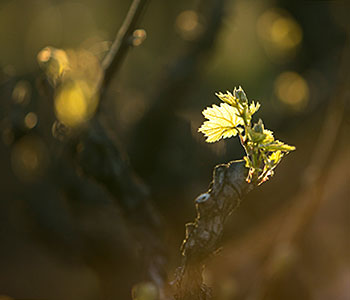
Budding in our vineyards
If you wander through the vineyards at the moment, you can see the first tender leaves on the vines. Many of them already beautifully developed, others have yet to unfold from the buds. Like every year, this is a very special time for walkers – and for winegrowers.
May 2023
It is the third spring, which is not as it should be. After two corona years, the nearby war is clouding the mood. The weather also leaves much to be desired. However, nothing can stop spring itself, and after the much-needed rains the world is in full bloom and fresh green. The shoots are also sprouting on the vines, an important time of year for the winegrowers.
Compared to many other plants and trees, vines sprout relatively late, between mid-April and early May, depending on the variety and weather. The imminent budding of the vines can be seen a few days beforehand when drops of water emerge from the cut ends of the shoots. This "weeping" or "bleeding" of the vine signals the end of the winter dormancy and the beginning of the sap-sprouting. The buds begin to swell until the woody bud scales break open and a felt-like ball of hair becomes visible. Beneath this lies the shoot tip, well protected. As the sap pressure increases, the felt-like meshwork swells more and more until the green shoots break through, gradually grow in length and finally unfold into small leaves. Up to this stage, the vine feeds on the carbohydrate reserves it has built up in autumn. As soon as the leaves are developed, the sugar supply and nutrition takes place via photosynthesis.
An average daily temperature of 8 to 10 degrees Celsius over several weeks is crucial for budding. In very warm years, this can already be the case in February due to climate change. In this case, budding occurs weeks too early. The young green shoots with a delicate structure and a lot of water in the tissue are at risk even in the case of light late frosts, and the vines in sap are at risk in the case of heavier frosts. 2023, on the other hand, is a year like the old days: only at the beginning of May can you see fresh green on the vines everywhere in the vineyards and the unfolding reddish-toothed leaves. Now they are almost on the safe side; late frosts are rare at this time of year. Except when the → Cold Sophia deals with her cronies, then danger is imminent. May she please restrain herself!
With budbreak, the first foliage work also begins: manually breaking out the weak shoots and reducing the number of shoots per vine. Until then, the winegrowers were busy with tying up: After winter pruning, the remaining shoots stand on the vine and point upwards. As soon as they are supplied with sap and are pliable, they are bent downwards to the wire frame and fastened. This allows the sap to flow evenly and supply all the shoots. There is also the "stock clearing", the soil underneath the vines has to be opened and loosened. This step aerates the soil and removes weeds. They prevent the constant aeration of the soil, increase the humidity and promote fungal infections. This can be done well with appropriate machinery, see this short film by the "Designwinzerin". The use of herbicides (e.g. glyphosate) should be taboo for this purpose and in general; unfortunately, in many areas you can still see brown burnt vine rows in spring, which bear witness to this. Poison for soil, vine and all living beings.
tween the rows of vines it remains green, where grasses, herbs, legumes and flowers are sown to supply nutrients to the soil and vines and to promote biodiversity. It still takes a while until the vines blossom: this takes place 45 to 90 days after budbreak, i.e. from mid-May to the end of June.




